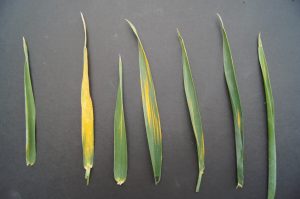Nathan Kleczewski, Extension Pathologist, University of Delaware
Stripe Rust is active in the Eastern shore of Virginia on susceptible wheat varieties. Last week I wrote an article on management recommendations and scouting information on the Field Crop Disease Management blog (hyperlink to article). Understanding your resistance rating to stripe rust is key in determining if this disease should be a concern for you if it moves into the area and temperatures remain cool and humid (below 70 F during the day, and 60F during the night). Check your seed catalogues or contact your dealers for ratings to stripe rust. Those growers planting varieties with very good to excellent resistance should not need to worry about additional fungicide applications. Those with susceptible varieties need to pay close attention to their fields and reports of the disease, and consider a fungicide application if the disease is detected nearby or in the field. Yield loss is related to the growth stage of the plant relative to arrival of the pathogen. Plants infected earlier in growth (prior to heading) may suffer significant losses under appropriate conditions.
Several people have asked about if leaf rust and stripe rust ratings are the same. No they are not.
Stripe rust on wheat. Notice the bright orange “pustules” that are arranged in long strips.
Resistance to these diseases is controlled by different genes and therefore a variety with excellent leaf rust resistance may not be resistant to stripe rust. Ratings for many stripe rust varieties in the region can be found at the Field Crops Plant Pathology website under the heading “Small Grains” as well as the Virginia Tech Small Grains Variety Trials webpage.
